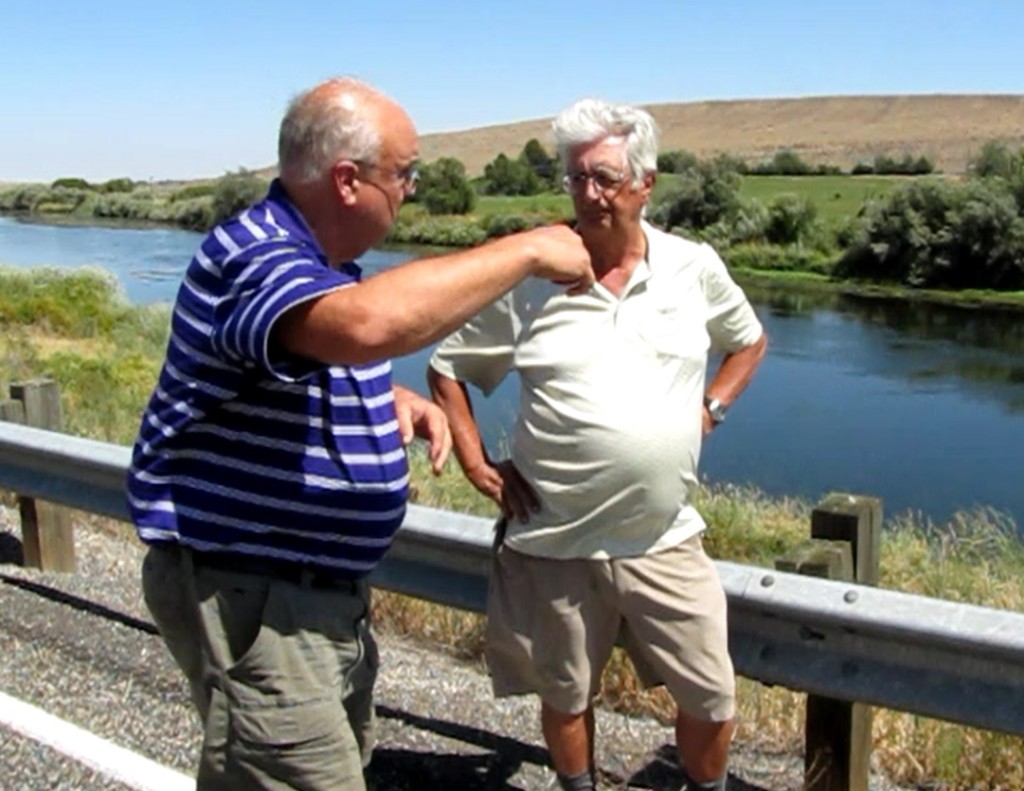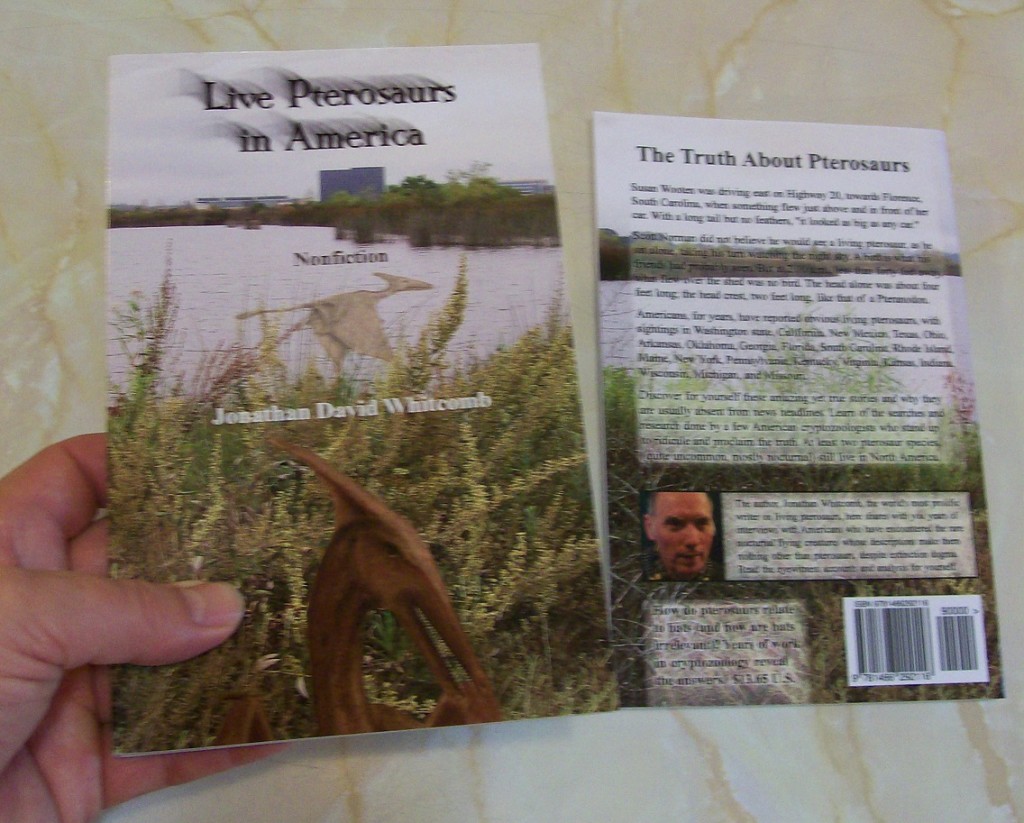Two Americans returned home to the Portland area of Oregon on Saturday, April 18, 2015, after having searched for a living pterosaur on New Britain Island in Papua New Guinea for several weeks. Not only did they see an apparent living pterosaur in daylight, but the biologist Peter Beach *recorded video footage of the flying creature, although the video quality is poor. This was the eleventh pterosaur expedition in which Americans were heavily involved in Papua New Guinea over the past twenty-two years, and it was the first such expedition in which an American visitor witnessed an apparent modern pterosaur in daylight. Many Westerners would call this kind of flying creature a “pterodactyl” or a “dinosaur bird”.
* (In the first report, right after they returned to the USA, it was incorrectly assumed that no photo or video was obtained; it was soon learned that video was obtained but of very poor quality.)

Pteranodon-like Pterodactyloid pterosaur
Not a Ropen but a Possible Pterodactyloid
At the time of the sighting, one or more natives caught the attention of the two Americans as the large creature flew overhead. One of the Americans had forgotten where he had put his camera, and the other tried to videotape the apparent Pterodactyloid pterosaur but in the excitement missed pointing the camera in precisely the right direction, which was to some extent towards the sun. (Neither American is a professional wildlife photographer.) Yet both men did see the form and features of the flying creature, and both of them got the impression that is was a pterosaur, and a limited amount of video footage was recorded of the flying creature.
It appeared to be short-tailed, however, and so it was unlike the long-tailed ropen that appears to be more common in Papua New Guinea. Is this Pterodactyloid-type also bioluminescent? We don’t yet know, for the new sighting, during this expedition in March and April of 2015, was in daylight.
Although the sighting was hardly a scientific proof of the existence of modern pterosaurs, we can learn from the experience. Let’s begin by going over who these men are: Peter Beach and Milt Marcy.

Milt Marcy (left) and Peter Beach, by the Yakima River, state of Washington
Dinosaur Search in Africa
According to Wikipedia:
In January 2006, the Milt Marcy Expedition traveled to the Dja river in Cameroon, near the Congolese border. It consisted of Milt Marcy, Peter Beach, Rob Mullin and Pierre Sima. They spoke to witnesses that claimed to have observed a Mokèlé-mbèmbé only two days before, but they did not discover the animal themselves. However, they did return with what they believe to be a plaster cast of a Mokèlé-mbèmbé footprint.
That was one of many expeditions in central Africa, over many years, by various Western explorers, in search of a non-extinct Sauropod dinosaur. A few of those American dinosaur “hunters” have also searched for living pterosaurs, including David Woetzel.
I specialize in modern pterosaurs, not modern dinosaurs, but I did interview Marcy and Beach in August of 2014, on the banks of the Yakima River in Washington state.
Bioluminescent Pterosaurs in Northwestern USA
Glowing nocturnal flying creatures in Washington state may appear irrelevant to sightings of apparent pterosaurs in Papua New Guinea, but Milt Marcy and Peter Beach have searched for them in both locations. We can learn at least one thing from that.
I found these two men quite credible, as I interviewed them in August of 2014, by the river where they had witnessed strange flying lights at night. They admitted that they were unable to see anything like a pterosaur in daylight, and almost all of their night sightings were only of the flying lights.
Some weeks after our interview, Marcy and Beach witnessed similar flying lights but over a different river in that northwestern area of the USA. Again they saw no form or features of a pterosaur. That brings up an important point.
Honesty in Searching for Living Dinosaurs and Pterosaurs
Is it possible that Milt Marcy and Peter Beach were dishonest when they returned from their African expedition in 2006, when they admitted that they had seen nothing like any dinosaur? How easy for a liar to make up a story, if a dishonest man were to go to some remote area of the planet where his lie could hide in the dark! How unbelievable that two men would try to deceive the world into believing in modern dinosaurs, when those two would spend their own money on an expedition and afterwards admit that they had seen nothing like a dinosaur!
Why did those two men tell me nothing about any sighting of an apparent pterosaur that they had seen in daylight at a river in the northwestern USA? They had no such sighting and were honest.
So why would Mr. Marcy tell me about an apparent pterosaur he had observed early in 2015 in Papua New Guinea, admitting that he was not 100% sure it was a pterosaur? He was still being honest.
And why would Mr. Beach hesitate when I asked him how sure he was that he had observed a pterosaur with Mr. Marcy in Papua New Guinea? He was trying to think of something else that it could have been. He was thinking of different birds and bats that may have presented the appearance of what he had seen that day with his friend Milt. He was being honest.
Peter Beach was once a biology professor at a small college. He is well aware that a human with a bias can observe something and misidentify it because of that bias. I give him credit for being careful about assuming that he and Milt must have seen a pterosaur. Both of these men have shown us honesty in their investigations.
So was it a Pterosaur?
I have spoken with both of them by phone this past week. I feel that the three of us agree that it is more than 50% likely that it was a living pterosaur they had observed in Papua New Guinea. So where does that leave us?
At the end of 2012, I compiled data from 128 of the more-credible sighting reports that I had received over many years. Each one of those 128 appeared to me to have been more than 50% likely to have been from an encounter with a living pterosaur. What does that mean? To those who understand probability, it means that if my assessment of each of those 128 reports was anywhere near the mark, it is practically impossible for all of those reports to have come from non-pterosaurs: Not all pterosaurs are extinct.
Who am I do declare myself objective enough to make such a proclamation? I have spent the past eleven years researching and searching for living pterosaurs, although most of the searching was for truth within eyewitness reports rather than for the creatures themselves. I appear to have written more on this subject than all other cryptozoologists in the world combined, in nonfiction books and web pages and blog posts, which does not in itself prove the validity of my ideas, proving only that I am serious. In 2004, I returned from an expedition in Papua New Guinea, admitting that I had seen nothing like a pterosaur. In 2013, I finished examining 14,333 game-camera photos of a location where such a flying creature had been reported, and I admitted seeing nothing like a pterosaur. By early 2015, I had received eyewitness reports from five continents of this planet, not rumors or second-hand reports but the words of the witnesses, from those persons themselves. As of April 24, 2015, I have never myself seen anything like a living pterosaur. In other words I am honest. To the point, honesty is the first step and the biggest step to objectiveness.
###
.
Pterosaur Sighting in Papua New Guinea Early in 2015
Peter Beach and Milt Marcy, both of the Portland area of Oregon, led an expedition in Papua New Guinea, in March and April of 2015, searching for a living pterosaur that previous American explorers had failed to see clearly. This time Americans did see, in daylight, the form and features of an apparent pterosaur.
Investigators of Reports of Living Pterosaurs
Garth Guessman, David Woetzel, Paul Nation, Jonathan Whitcomb—each of these four American men has explored in Papua New Guinea, searching for a living pterosaur.
Flying Pterosaur Creature
The problem is not in the eyewitnesses but in the indoctrination, over generations, that all species of dinosaurs and pterosaurs must have become extinct millions of years ago. That’s the problem.
Sightings of Flying Creatures
[In] July of 2010, My wife and I were sitting outside when motion from above the tree tops to our left caught my attention; it’s very hard to explain how I felt at that moment. We were looking at two extremely large birds flying together and heading north . . . I can only guess to be 15-20′ wing spans and the motion of their wings as they flew was very slow.
Can Ropens Hide in Caves?
Last month, I learned about multi-eyewitness sightings of flying lights in the northwestern United States, lights that the observers believe are bioluminescent pterosaurs, possibly ropens. Its seems these lights fly over at least two rivers in this part of the country and near one particular river the lights enter and exit nearby caves.
Bioluminescent Pterosaurs in Washington State
The flying creatures are nocturnal, not usually seen there in daylight . . . I emphasize that sightings of apparent living pterosaurs are throughout the states of Washington and Oregon . . . We were unable to get a picture but we saw many . . . flashing lights. I would have assumed that [they] were fireflies but we [don’t] have them in Washington.
.

Probably the best-selling nonfiction book on modern “pterodactyls” – Live Pterosaurs in America (third edition) by the cryptozoologist Jonathan David Whitcomb
From the Amazon page:
Reports of huge flying “pterodactyls” in American skies have floated around the internet for years; but before about 2005, details were scarce. . . . Universal pterosaur extinction has been an assumption; some pterosaur species are still living. The author, one of those American explorers who interviewed natives in Papua New Guinea, has been interviewing American eyewitnesses since 2004.
.




 Fourth edition of
Fourth edition of